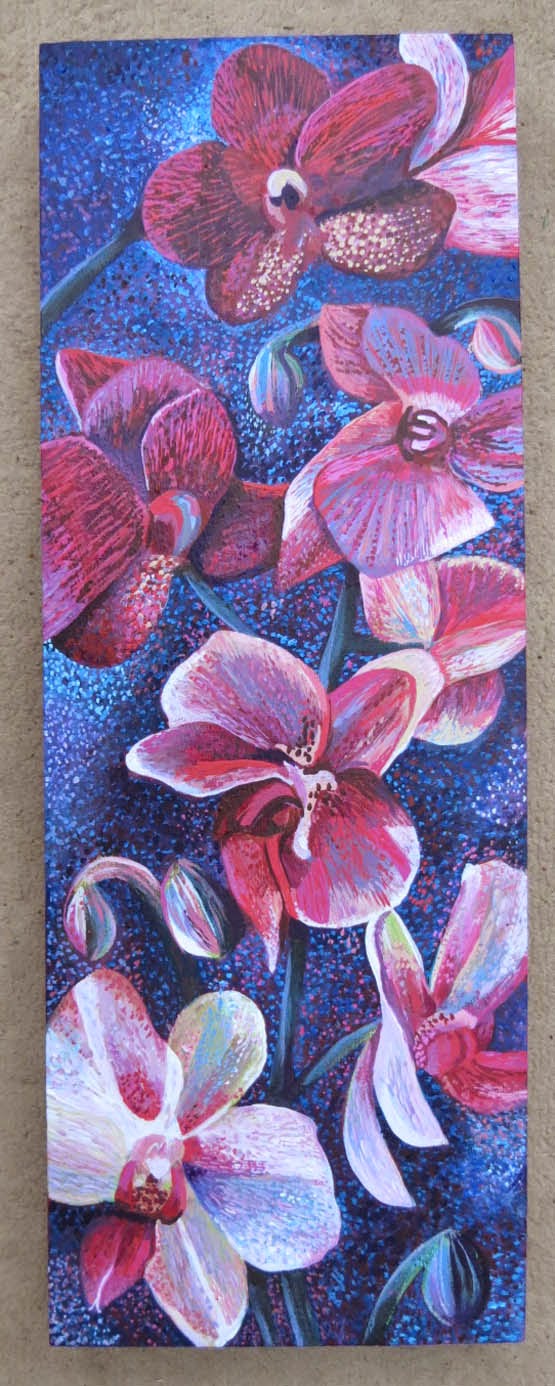I have painted some wonderful Canna lilies that I photographed a couple of months ago. They were coming to the end of their flowering season, so some of the petals were starting to fade. This actually made them more interesting to paint due to the greater range of colours displayed.
Here are the final paintings, followed by a step by step showing how I painted them.
I decided to paint a pair of paintings, as I had some lovely long thin canvases, which seemed an interesting shape to paint on!
I painted the canvases all over with Paynes Grey. I used System 3 paint for this bit. I wanted a dramatic contrasting colour scheme right from the start.
I drew the outlines with pencil and then went over it with white paint. At this stage I am only thinking about the flowers, not the leaves.
I next start working in some of the shades of yellow, orange and red that make up the petals.
Following this I continue to add detail by building up the layers of paint. I am using an acrylic gouache, so it dries quickly enabling me to build on my work without having to wait for much drying time. The paint I am using is by AV Vallejo, and there is a link to where you can buy it on the side bar of this page.
Here I am just showing a close up of the top of the painting. I haven't really thought about the leaves at this stage!
Next I put in some leaf outlines. Canna lilies have lovely striped leaves, that are as interesting as the flowers.
I then add some green paint to the leaves. Its fairly basic at this stage, just to define the shapes.
As you can see I have used a wide range of colours in these paintings. You see more every time you look at it. It has been an enjoyable experience painting these, and I have already started a new painting of three Canna lilies, on just one canvas this time! I shall aim to get a very different finished result this time. I will put the results on this blog when completed.
Comments always appreciated.
Here are the final paintings, followed by a step by step showing how I painted them.
I decided to paint a pair of paintings, as I had some lovely long thin canvases, which seemed an interesting shape to paint on!
I painted the canvases all over with Paynes Grey. I used System 3 paint for this bit. I wanted a dramatic contrasting colour scheme right from the start.
I drew the outlines with pencil and then went over it with white paint. At this stage I am only thinking about the flowers, not the leaves.
Here I am just showing a close up of the top of the painting. I haven't really thought about the leaves at this stage!
I then add some green paint to the leaves. Its fairly basic at this stage, just to define the shapes.
After this I start to play about with the leaf colour. I add some crimson and purple shades.
I then start to think about lighting. I want to give the impression that these are backlit. I start increasing the contrast of colours and shading on the leaves. I deepen areas where stems and leaves overlap. I have also added more detail and contrast to the flowers.
My next stage is to neaten up the stripes on the leaves. This takes quite a while to do. I am using a size 1 and 0 brush for some of the smaller detail.
My painting is now finished ! I have reduced the size of a couple of leaves, where they overcrowded the flowers. I have used a very dark purple and blue to add textured dots over the background. This enhances the negative shapes, and draws your eye around the work. I am a great believer it not having a plain background, when it can become a more integral part of the work.
I have added loads of small detail all over, emphasizing veins and colours on the flower petals, and stripes on the leaves. The colours are a lot more vivid.
Here are a few close ups so you can see the techniques used.
As you can see I have used a wide range of colours in these paintings. You see more every time you look at it. It has been an enjoyable experience painting these, and I have already started a new painting of three Canna lilies, on just one canvas this time! I shall aim to get a very different finished result this time. I will put the results on this blog when completed.
Comments always appreciated.



















































